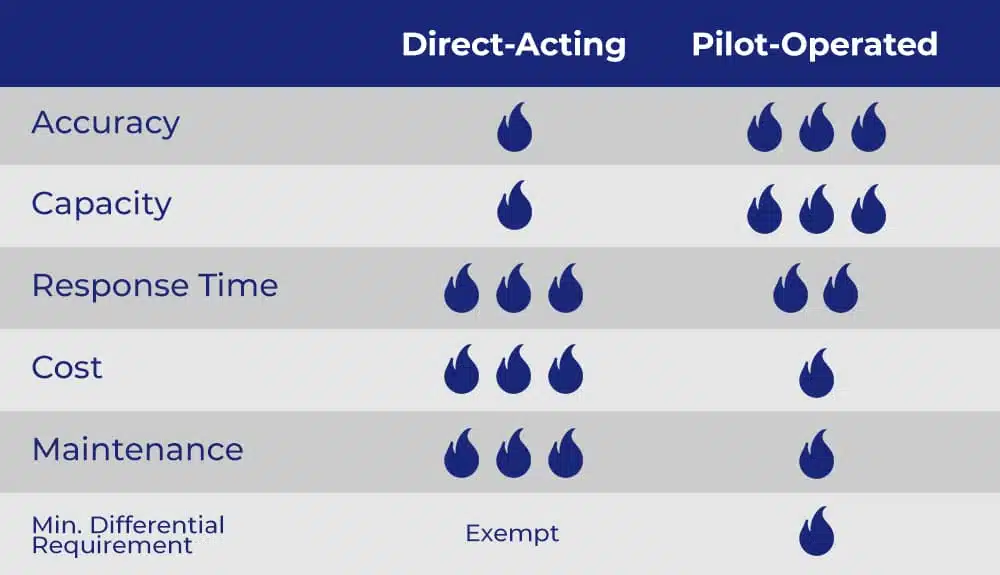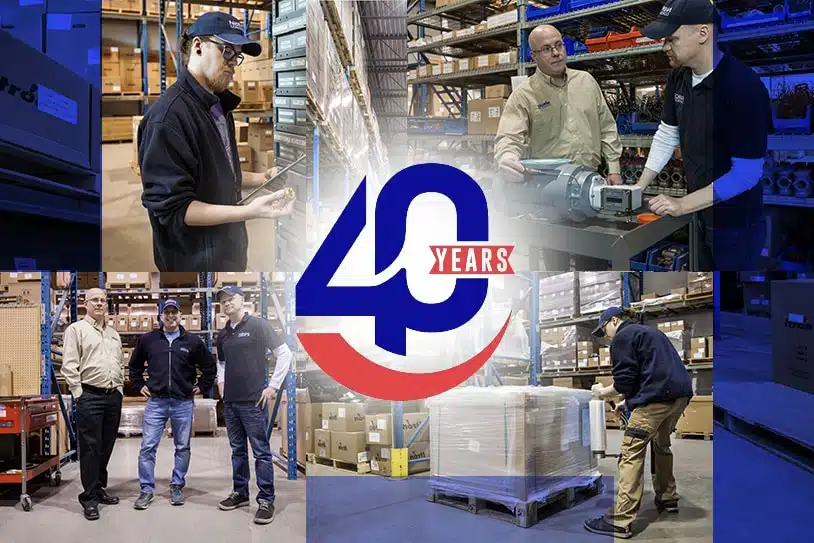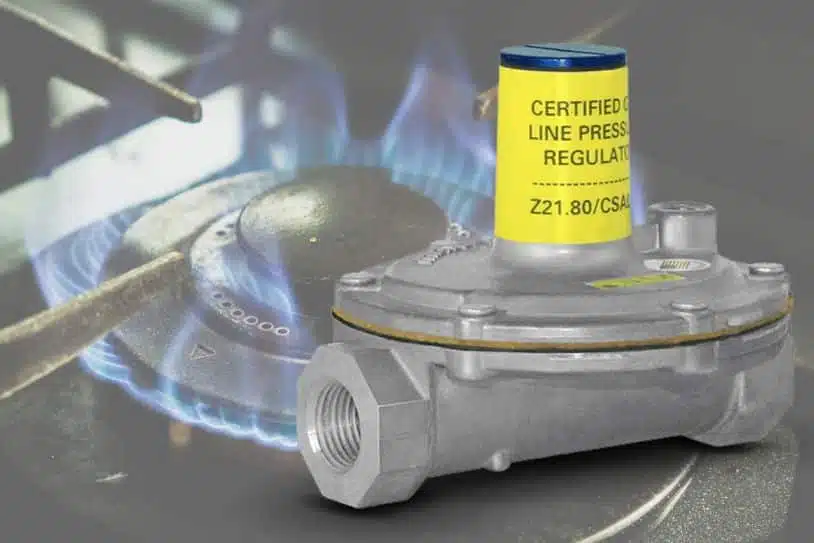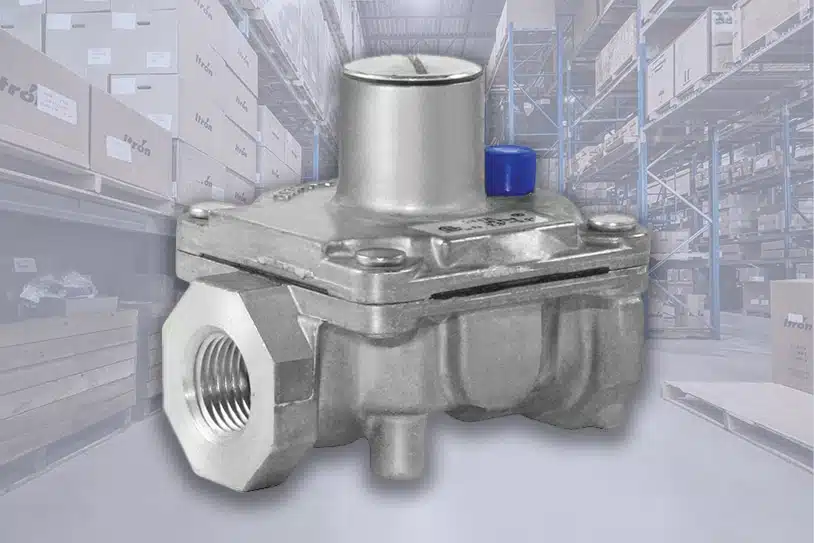Differences Between Direct Acting and Pilot Operated Gas Regulators
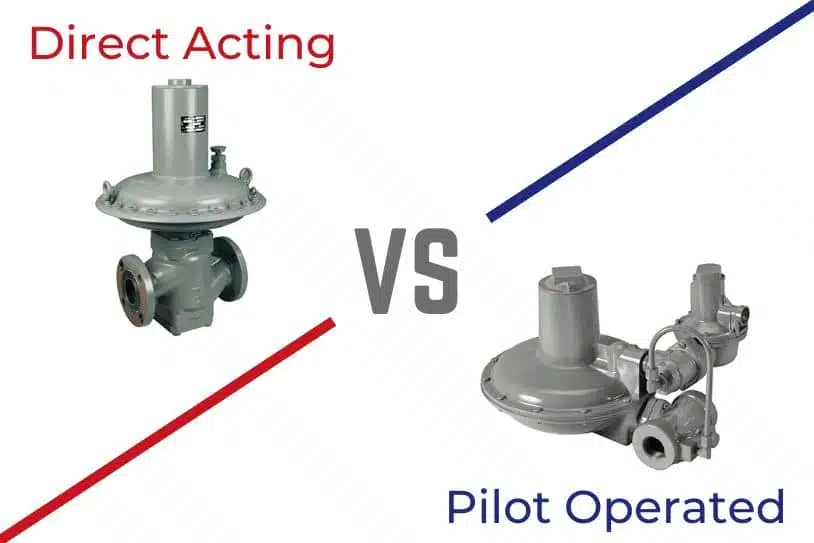
A pressure-reducing valve, also called a pressure-reducing regulator, is typically used in the oil & gas, water, and steam industries to reduce the excess unregulated pressure in a system. There are several types of gas regulators that are classified into two categories, pilot-operated and direct acting. Below is information on what differentiates these regulators to help you understand what is best for your application.
What is a Direct Acting Pressure-Reducing Regulator?
A direct acting regulator is a simple valve that operates with a convoluted bellow or a flat diaphragm. Its downstream has no external sensing line since it is self-reliant. With this pressure relief valve, you can expect accuracy levels of +/- 10% of its downstream set point.
There are three main functional elements in a pressure relief valve. These include:
- The restricting element is a valve, typically a spring-loaded poppet valve. It provides a variable flow restriction.
- A measuring element determines the point at which the inlet and outlet flows are equal. This is the diaphragm.
- A loading element applies the necessary pressure on the restricting element. This is the spring.
When in operation, a pressure-reducing valve will remain closed until downstream pressure reaches a set point. The valve will then crack open and continue opening to increase flow with a pressure increase. When the downstream pressure falls, the valve closes again.
In a direct acting pressure relief valve, the valve is directly opened by a movement of its adjusting spring. The spring’s compression generates an open force on the valve to increase flow. As the pressure downstream accumulates, feeding this pressure to the adjustment spring’s underside equalizes it through an upward force that counterbalances the spring’s compression. The spring has a limited compressive force to support adequate spring sensitivity and balance downstream pressure changes.
The internal parts of a direct-operated valve only move when the diaphragm senses an outlet pressure change. When an increased flow demand makes the regulator sense a decreased outlet pressure, this causes a decrease in the upward force placed on the diaphragm and moves the plug down and away from the orifice. The resultant additional flow tries to meet the increased demand. If a regulator does not open enough to meet the demand, the downstream pressure further decreases to increase the orifice opening. This phenomenon is called a droop and affects a regulator’s accuracy.
As a gas regulator, a direct acting pressure-reducing regulator is often used in low-pressure and small-caliber environments. When the valve opens, it starts at zero pressure without requiring the minimum medium pressure. Therefore, the valve has a faster start-up speed than the pilot-operated valve. This makes it ideal for operations that need quick disconnection and connection.
What is a Pilot Operated Pressure Reducing Regulator?
A pilot operated pressure relief valve is also called a balanced relief valve. Its pilot valve loads a diaphragm or piston to increase the downward force in a system that, in turn, opens a larger primary valve. The pilot valve’s opening and closing is controlled by a balance of the force between secondary pressure and the adjustment spring. The valve delivers pressure to the main valve diaphragm or piston.
The downward pressure the pilot flow delivers is augmented by the diaphragm and piston that support the opening of the larger primary valve to enable very high flow rates. The amplification causes a change in the pilot valve opening to generate a significant difference in downstream pressure and flow through the primary valve. As such, modifying the force of the adjustment spring gets a quick response over several steam flow rates. The leading advantage of using a pilot-operated pressure relief valve is its tight downstream pressure control.
Choosing Between a Direct Acting and a Pilot Operated Regulator
Below are some differences to keep in mind when choosing between a direct acting and pilot operated pressure relief valve.
Accuracy
A pilot operated regulator is more accurate than the direct acting one. While pilot operated regulators require a 1-5% offset from the setpoint, direct acting regulators typically require a 20-40% offset. Some direct operated regulators meant for low-pressure designation, usually below one psi, can improve their accuracy through boost. Boost will counter the effects of droop through an extension of the flow rate designed for the regulator to uphold accurate pressure control.
Capacity
If you are operating a system with a large capacity, your best choice is pilot operated regulators since these come in larger sizes that can handle higher capacities. All the flow capability of a pilot operated regulator is usable because of its exceptional accuracy, unlike the limited flow capacity of a direct acting regulator due to excessive droop.
Response Time
A direct-operated regulator has a faster response speed owing to diaphragm movements because of outlet pressure changes. The diaphragm is directly connected to valve plug travel. Though a pilot-operated regulator works similarly, its loading pressure should change before the main valve is repositioned. This lengthens its response speed.
Minimum Differential Requirement
You have no minimum differential requirement with a direct acting pressure regulator. You can keep controlling it irrespective of its pressure differential. On the other hand, pilot operated regulators need a pressure differential between the outlet and inlet to keep the main valve open.
Maintenance and Cost
Direct operated pressure regulators are uncomplicated and compact. This makes them inexpensive and easy to maintain. Conversely, pilot operated regulators have higher upfront and maintenance costs owing to their complex designs.
Purity of the Medium
A pilot operated regulator has a higher requirement for the purity of the medium flowing through it. On the other hand, a direct acting regulator does not have this strict requirement.
Pressure Tolerance
A pilot operated pressure regulator has higher tolerance levels for liquid pressure compared to a direct acting regulator.
In Conclusion
Pressure-reducing regulators are essential for reducing pressure in a given system while maintaining a constant outlet pressure based on your flow demand. Accuracy, capacity, and response time are key factors that will influence the selection of the right pressure-reducing valve for your application.
The pilot operated regulator has a higher accuracy and capacity than direct acting regulators. However, a direct acting regulator has a faster response speed, no strict requirements for the purity of the medium flowing through it, and no minimum differential requirement. Moreover, direct acting regulators are inexpensive and easy to maintain.
Norgas offers a selection of direct acting regulators and pilot operated regulators for specific applications. We have a large inventory of products and parts in stock and can customize regulators to meet your unique requirements. Contact one of our experts to find out how we can help you.
